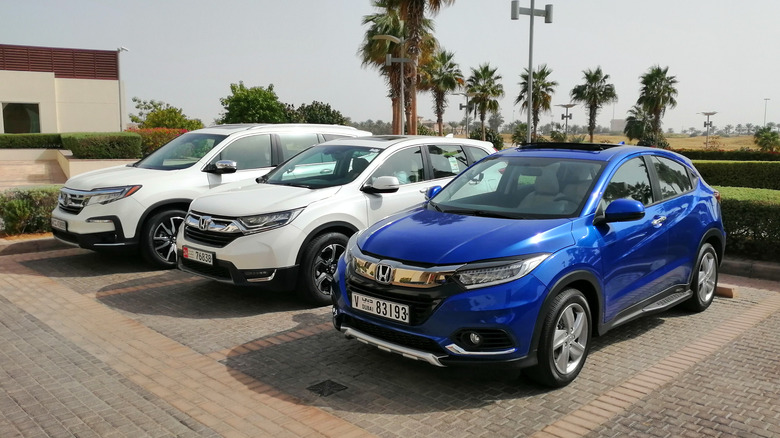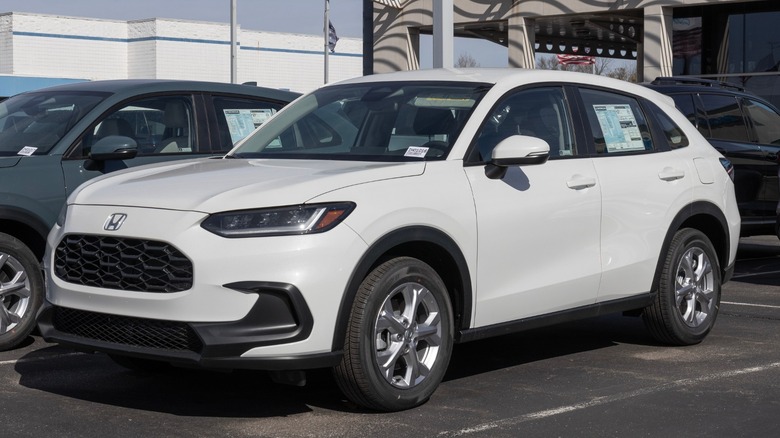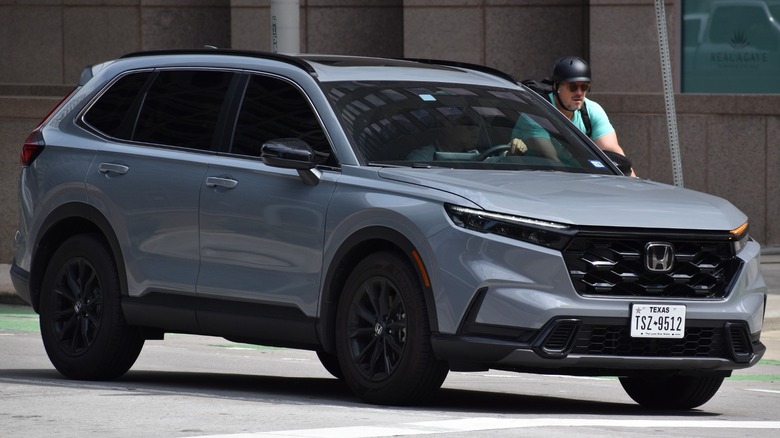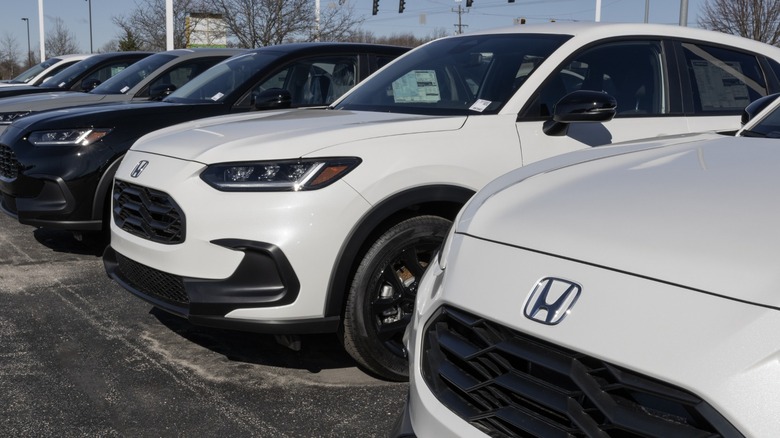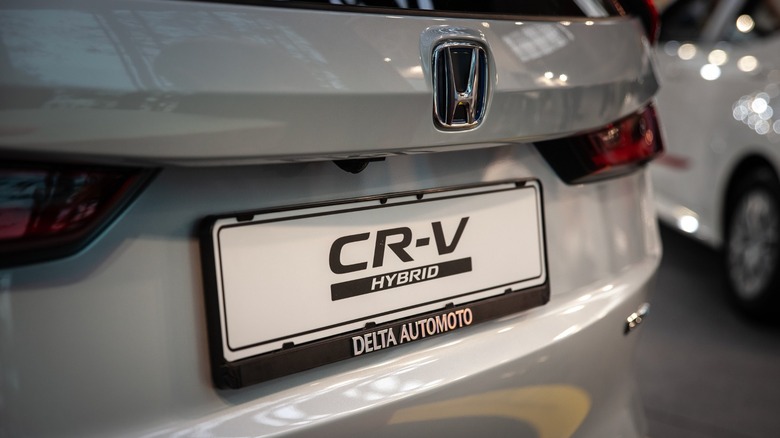What's The Difference Between The Honda HR-V And The CR-V?
You can't go wrong with a reliable car brand, and Honda is known for making reliable models. So, if you're in the market for an SUV and you have a $30,000 budget, you might be looking at the 2025 Honda CR-V and HR-V. Many have, as the current generation HR-V and CR-V are among Honda's best-selling SUVs of all time.
Unless you have a lot of money burning a hole in your pocket, you're likely limited to picking just one of these. While the base trim 2025 HR-V starts at around $25,000, its top trim option falls a bit under $30,000. On the other hand, the 2025 CR-V's entry-level trim is a little over $30,000, with the most expensive option going for over $40,000. Since both cars have a price overlap at $30,000, it can be difficult to choose between them, especially if you have some leeway on your spending limit.
What makes this an extra hard decision is that both models are great SUVs. So, to help you pick out the right Honda for you, let's compare the differences between the 2025 HR-V and the CR-V.
What Is the Honda HR-V?
The Honda HR-V is a subcompact SUV based on the Honda Civic. It has a two-liter four-cylinder engine under the hood, putting out 158 hp at 6,500 rpm and 138 lb-ft. of torque at 4,200 rpm. Because it's a subcompact SUV, it's going to be smaller than its bigger brother, the CR-V.
The HR-V's front fascia offers a more aggressive look than the CR-V. And, despite its more affordable price and smaller dimensions, the car offers a whole suite of features and creature comforts that can rival just about any subcompact SUV and even some compact SUVs on the market. If you're the adventurous type, you can option this car with Real Time AWD for more versatility and safety on difficult terrain. The top-trim EX-L also gives you luxuries like a Moonroof, leather-trimmed seats, an eight-speaker entertainment system, and dual-zone automatic climate control.
What Is the Honda CR-V?
The Honda CR-V is one of the most popular nameplates in the Honda lineup and is currently in its sixth generation. The 2025 model also starts at $30,100, meaning you might get tempted to move up to it if you're already considering the most expensive HR-V. The CR-V is a larger vehicle, and the tradeoff between features and size might be worth it.
The base model gets a more powerful turbocharged 1.5-liter inline-four engine, giving you 190 hp at 6,000 rpm and 179 lb-ft of torque from 1,700 to 5,000 rpm. If you choose the hybrid version, the power is bumped up to 204 hp. Even at its most basic trim level, you're getting a lot of features with the CR-V. Honda Sensing is standard, you still get automatic climate control, ambient lighting, push-button start, and Apple CarPlay and Android Auto, although you lose out on the Moonroof and power tailgate. Plus, the current-generation model encompasses some of the best years for the CR-V.
Subcompact vs. compact SUV
Aside from the looks, the biggest and most obvious difference between the 2025 Honda HR-V and the CR-V is size. As the smaller car of the two, the HR-V has a 104.5-inch wheelbase, and its dimensions (L x W x H) are 179.8 x 72.4 x 63.4 inches. The base 2WD model weighs 3,159 pounds. The CR-V has a 106.3-inch wheelbase, and it measures 184.8 x 73.5 x 66.2 inches (or 66.5 inches for the AWD version). It also weighs 3,472 lbs. for the entry-level trim, while the top-end AWD model comes in at 3,926 lbs. This makes the CR-V five inches longer than the subcompact SUV and hundreds of pounds heavier. This makes the CR-V five inches longer than the subcompact SUV and hundreds of pounds heavier.
The HR-V's interior space is also smaller, but the differences aren't significant. Its headroom is marginally less at 39.4 and 38 inches for front and rear, compared to the CR-V's 40 and 38.2 inches. The two models have similar legroom up front, but the backseats of the CR-V bump the HR-V's 37.7 inches to 41. The rear cargo space in the HR-V can accommodate 24.5 cu-ft with the seats up, and this more than doubles to 55.1 cu-ft when they're folded flat on the floor. The CR-V' has significantly more cargo space, with 39.3 cu-ft capacity with the seats up. If you fold down the rear seats, this increases to 76.5 cu-ft, making the CR-V a much more practical utility vehicle.
Fuel consumption and HEV option availability
Since the HR-V is a smaller car, it's easy to assume that it's the more fuel efficient of the two. However, the CR-V's smaller turbocharged 1.5-liter engine actually gives it an advantage.
According to Honda, the HR-V gets 26 mpg in city driving conditions (25 for the AWD version) and 32 mpg on the highway (30 for AWD), resulting in a combined EPA rating of 28 mpg (27 for AWD). On the other hand, the CR-V gets 28 mpg in the city (26 for AWD) and 34 mpg on the highway (31 for AWD), resulting in a combined EPA rating of 30 mpg (28 for AWD).
Alternatively, if you can afford the extra cash, you can get the hybrid version of the CR-V, which starts at $34,350. The Sport Hybrid trim bumps the efficiency up to 43 mpg in the city (40 for AWD) and 36 mpg on the highway (34 for AWD), for a combined EPA rating of 40 mpg (37 for AWD).
